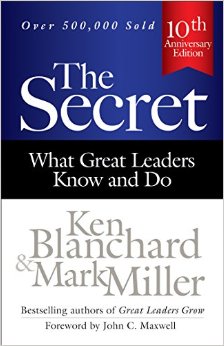Over the holiday week, I read The Secret: What Great Leaders Know and Do by Ken Blanchard and Mark Miller. I have to admit, for most of my life I’ve disliked the term “leader.” When you’re growing up, it seems like in school, at work, and on sports teams, everyone is trying to make you rise up and “be a leader.”
This message is echoed by hundreds of television shows and movies you are exposed to as a kid, from The Lion King to Lord of the Rings. I never really had any desire to be a public leader. I always wanted to be the person behind the scenes, pulling the puppet strings. Either that, or one of the villains, because they seemed far more interesting.
As I’ve grown older and wiser, I’ve come to realize that being a leader is more than just being a public figure and that it’s not just some made-up position that teachers push you towards because it’s seen as being “positive” in society. Being a leader expands the scope of your impact on the world, because it allows you to act through others.
 This book broke down the basics of what it takes to be a leader in a business context and the purpose of a leader in an organization. It also did it in a fun way!
This book broke down the basics of what it takes to be a leader in a business context and the purpose of a leader in an organization. It also did it in a fun way!
Rather than boring chapters or dry explanatory text, the authors made a genius move to layout the entire book in story format.
As the reader, you follow the story of a young up-and-coming female manager who is having team performance issues. Initially, she believes that there is a problem with the team and wants help from a mentor to identify what she needs to change. Over time, she realizes that it’s not the team that has an issue. She needs to become a stronger leader!
Regular mentorship sessions with one of the highest ranking mentors in the program leads to gradual progress and realizations about what is required to motivate others and inspire awesome on-the-job performance.
The main message of the book is broken down into the acronym “Serve.” Which stands for:
S – See the Future
It’s important for every leader to have a clear vision for the future and what he or she wants to accomplish. When everyone knows and understands the vision, it makes it easier to come up with ways to get there and to decide when opportunities are not in-line with that path.
E – Engage and Develop Others
For me, I think this is the hardest part of the leadership equation. Under this principle, you must actively work to bring the best out in others and make sure that they are maximizing their potential.
When thinking about this point, it helps me to bring to mind the Starship Enterprise. Under the leadership of James T Kirk, his team must navigate rough interstellar waters and combat enemies.
If each member of his team does not perform well, then the ship as a whole will suffer. In addition, every member must be suited to their strengths. You wouldn’t find Bones in engineering or Spock as ship’s counselor. Because each person is playing to their strengths and in the appropriate role, the entire organization benefits.
R – Reinvent Continuously
This point is more salient for leaders in business organizations, because any business that is not continuously re-inventing itself is dying. Product revenue streams will only last for so long.
Dedicating time to figuring out how to get more per-worker output by introducing new technology will go a long way to maximizing the impact a leader can have. Also, by improving on processes and killing those that aren’t helpful, the leader can maintain a streamlined team and efficient working environment.
V – Value Results and Relationships
Most people, myself included, tend to think of business life as being in a vacuum. Workers show up on Monday and leave on Friday. However, employees are not robots! They do other things during their non-work hours and have thoughts, feelings, and aspirations.
By understanding your coworkers or employees, you can help understand what may be affecting their performance, whether that is positive or negative. You will also be able to better align their own aspirations and values with the goals of your company.
Naturally, results should always matter more than titles in any company. The organization should be a meritocracy to ensure continued performance.
E – Embody the Values
Finally, the best way to establish trust and credibility with your followers is to embody the values of your organization. If you’re saying that you appreciate strong customer service, but never reward it, or you praise an action that goes against that value, it will make people skeptical about other promises, values, and plans you make.
Honesty is synonymous with congruency. If your thoughts or words are incongruent with your actions, it will erode trust and make people question whether or not you mean what you say. Without this fundamental relationship, it will be impossible to effectively lead your organization to new horizons or through choppy waters.
Should you read this book?
If you’re new to the concept of leadership and are interested in learning about it in a business context, I think this book is a great place to start, and it’s a fast read!
I don’t think it’s a good fit if you are familiar with the topic and really want to dive in deep. Instead, it will give you more of a basic overview.
Ken Blanchard and Mark Miller have written two other books that might be worth looking into, Great Leaders Grow: Becoming a Leader for Life or The Secret of Teams: What Great Teams Know and Do.
I’d love to hear what you think if you read this book! Leave a comment below.
Food for thought: Are you a serving leader or a self-serving leader?

Thanks for this summary Salvador, I know you wrote it a year ago, but I want you to know it helped me a lot today.
So happy to hear this!! Glad it was helpful :).